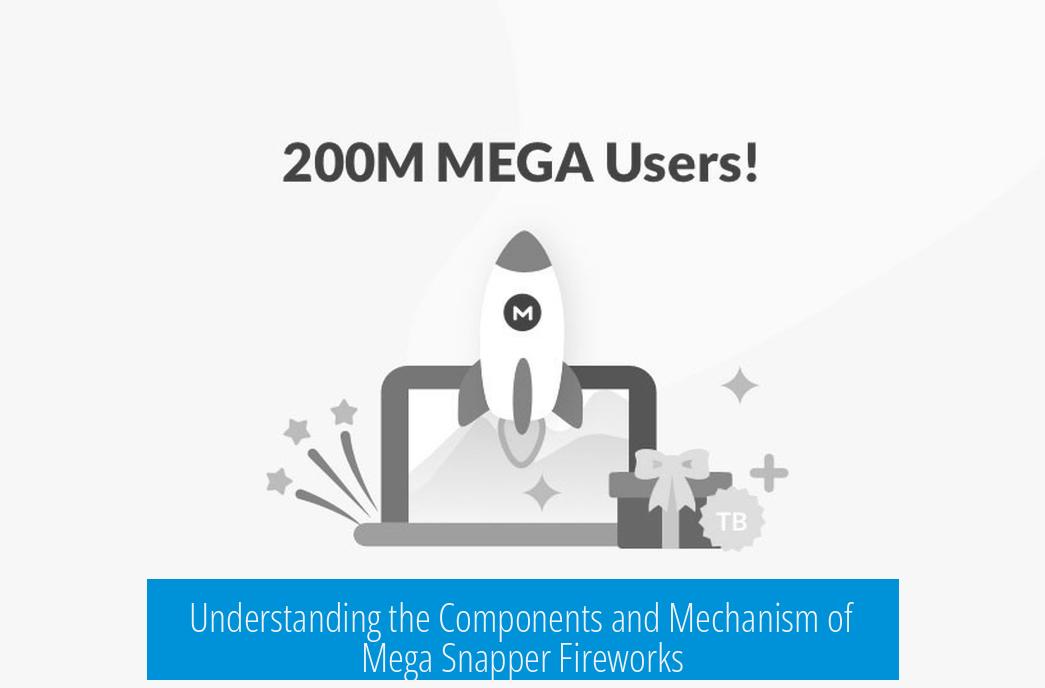How Mega Snapper Fireworks Actually Work
Mega snapper fireworks produce their characteristic snap through a small explosive charge composed primarily of silver fulminate mixed with flash powder, packed inside a rolled paper tube sealed by red clay caps and containing small inert pellets coated with explosive dust to create friction and initiate detonation upon impact.
Explosive Components Inside Mega Snappers
The core explosive material in mega snapper fireworks is silver fulminate. This compound acts as the primary chemical that detonates upon impact. Its quantity inside each snapper is very small but sufficient to produce the sharp cracking sound.
- Silver Fulminate: A sensitive, impact-activated primary explosive responsible for ignition and detonation.
- Flash Powder: Mixed alongside silver fulminate to boost the explosive power through rapid combustion and enhanced pressure generation.
The combination of these two materials creates a pressure difference inside the firecracker when triggered by impact. The flash powder accelerates the reaction and intensifies the “snap” effect.
Physical Structure and Contents
Each mega snapper firework is constructed using a rolled paper tube that contains the explosive mixture. The tube ends are capped and sealed with a clay mixture, often red-colored, which acts as filler material, holds the contents firmly, and ensures the explosion is contained momentarily to increase pressure.
Inside the tube, there are many small pellets described as dark-ish grey. These pellets are not themselves explosive but serve a critical functional role.
- Small Inert Pellets: Usually hard, inert stones or ceramic balls.
- Coating: Their surfaces are lightly coated with silver fulminate dust, enough to be reactive on impact.
- Purpose: They create friction when struck or compressed, essential for initiating the explosive reaction.
Some pellets remain “unexploded” because only small amounts of the silver fulminate coating detonate while the bulk inert pellets persist.
Mechanism of Detonation
The mega snapper’s detonation relies on the interaction between the coated pellets and the explosive compound during impact.
- Impact: The snapper is thrown or compressed, causing the pellets to rub against each other and the tube’s interior walls.
- Friction and Pressure Build-up: This friction generates localized heat and pressure, triggering the silver fulminate dust to ignite.
- Explosion: The silver fulminate detonates instantly, rapidly expanding gas pressure inside the sealed tube.
- Sound Output: The sudden gas expansion causes the tube to burst with an audible snap sound.
Remarkably, only minimal quantities of silver fulminate are necessary for this chain reaction. The coated pellets provide the bulk and mechanical means to ensure initiation but are not themselves explosive.
Common Misconceptions About Components
Many assume these fireworks contain mercury fulminate or potassium chlorate mixtures. However, mercury fulminate is too unstable for safe commercial use in toys. Flash powder combined with silver fulminate is the realistic and widely accepted composition.
- Mercury fulminate is avoided due to excessive sensitivity and instability.
- Potassium chlorate with sulfur is common in other pyrotechnics but not typical for mega snappers.
- Tri-nitrogen iodide and other contact explosives are unrelated chemically but sometimes confused with snapper chemistry.
Safety and Handling Considerations
Handling mega snapper fireworks requires caution. Opening or attempting to modify these devices is hazardous due to their sensitivity.
- The small silver fulminate charges detonate easily upon friction, compression, or impact.
- Even slight disturbance while disassembling may trigger an unexpected explosion.
- They are designed to explode on impact safely but become dangerous when manipulated improperly.
Users should not attempt to open or combine multiple snappers to create stronger explosive effects. The risk of accidental detonation increases substantially under such circumstances.
Summary of Mega Snapper Firework Composition and Function
| Component | Description | Function |
|---|---|---|
| Silver Fulminate | Primary impact-sensitive explosive compound | Ignites and detonates to produce snap |
| Flash Powder | Secondary explosive mixed with silver fulminate | Enhances pressure and combustion rate |
| Rolled Paper Tube | Container for explosive mixture | Holds contents and helps pressure build-up |
| Red Clay Caps | Seals tube ends | Keeps mixture compact and generates confinement |
| Small Inert Pellets | Non-explosive coated stones/balls with silver fulminate dust | Provides friction and pressure to initiate detonation |
Key Takeaways
- Mega snapper fireworks contain silver fulminate and flash powder as explosive components.
- Small inert pellets coated with explosive dust generate friction necessary for ignition.
- The reaction occurs in a paper tube sealed with clay ends, creating pressure that causes the snap sound.
- Only tiny amounts of silver fulminate are needed for detonation.
- Handling or opening these devices carries a risk of unexpected explosions.
What materials are inside a mega snapper firework that make it explode?
Mega snappers contain silver fulminate as the main explosive. They also include flash powder. These are packed inside a rolled paper tube sealed with red clay.
Why do some small pellets inside mega snappers not explode?
Those pellets are inert stones coated with silver fulminate dust. They help create friction and pressure but are not themselves explosive. Some remain unexploded after use.
How does the explosion happen inside a mega snapper?
When impacted, friction forms between the coated pellets and silver fulminate dust. This friction ignites the silver fulminate, causing rapid combustion and pressure buildup that leads to the snap.
Is there a lot of explosive material inside these snapper fireworks?
No, very little silver fulminate is used. Just enough to cover the pellets and create the reaction. The stones add bulk but do not increase the explosive amount.
What holds the explosive materials inside the mega snapper’s shell?
The explosive mix sits in a rolled paper tube. Both ends are sealed tightly with a red clay mix that also serves as a filler and secures the components.





Leave a Comment